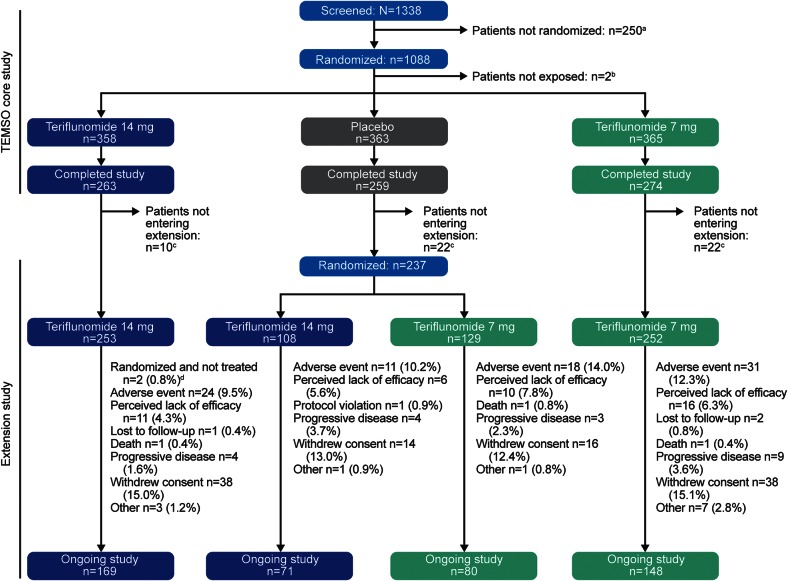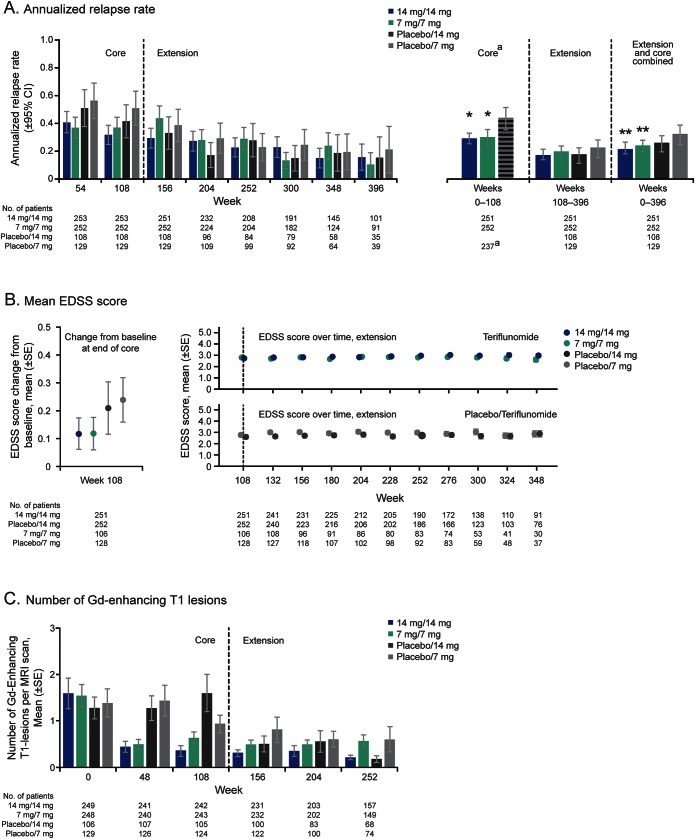Abstract
Objective:
To report safety and efficacy outcomes from up to 9 years of treatment with teriflunomide in an extension (NCT00803049) of the pivotal phase 3 Teriflunomide Multiple Sclerosis Oral (TEMSO) trial (NCT00134563).
Methods:
A total of 742 patients entered the extension. Teriflunomide-treated patients continued the original dose; those previously receiving placebo were randomized 1:1 to teriflunomide 14 mg or 7 mg.
Results:
By June 2013, median (maximum) teriflunomide exposure exceeded 190 (325) weeks per patient; 468 patients (63%) remained on treatment. Teriflunomide was well-tolerated with continued exposure. The most common adverse events (AEs) matched those in the core study. In extension year 1, first AEs of transient liver enzyme increases or reversible hair thinning were generally attributable to patients switching from placebo to teriflunomide. Approximately 11% of patients discontinued treatment owing to AEs. Twenty percent of patients experienced serious AEs. There were 3 deaths unrelated to teriflunomide. Soon after the extension started, annualized relapse rates and gadolinium-enhancing T1 lesion counts fell in patients switching from placebo to teriflunomide, remaining low thereafter. Disability remained stable in all treatment groups (median Expanded Disability Status Scale score ≤2.5; probability of 12-week disability progression ≤0.48).
Conclusions:
In the TEMSO extension, safety observations were consistent with the core trial, with no new or unexpected AEs in patients receiving teriflunomide for up to 9 years. Disease activity decreased in patients switching from placebo and remained low in patients continuing on teriflunomide.
Classification of evidence:
This study provides Class III evidence that long-term treatment with teriflunomide is well-tolerated and efficacy of teriflunomide is maintained long-term.
Teriflunomide (Aubagio; Genzyme, Cambridge, MA) is a once-daily oral immunomodulator approved for relapsing-remitting multiple sclerosis (RRMS). Teriflunomide selectively and reversibly inhibits dihydro-orotate dehydrogenase, a key mitochondrial enzyme in de novo pyrimidine synthesis. This exerts a cytostatic effect on proliferation of activated T and B lymphocytes, potentially limiting their contribution to multiple sclerosis (MS) pathogenesis.1
Three randomized placebo-controlled trials in relapsing MS supported the registration and approval of teriflunomide for RRMS treatment. Collectively, these studies demonstrated efficacy of teriflunomide on disability, annualized relapse rate (ARR), and MRI markers of disease.2–4 The trials demonstrated a consistent safety and tolerability profile for teriflunomide used for 2 years.2–4 A randomized trial comparing subcutaneous interferon (IFN)–β-1a with teriflunomide in relapsing MS demonstrated that efficacies of teriflunomide 14 mg and IFN-β-1a were in the same range, and treatment satisfaction was greater with teriflunomide.5
To collect long-term safety data and monitor disease activity with continued teriflunomide treatment, extension studies were established. An extension of the phase 2 study (NCT00228163, initially including 147 patients)6 has followed patients for up to 12 years,7,8 the longest clinical trial of any oral disease-modifying therapy for MS. Analyses at 8.5 years showed that teriflunomide maintained its established safety and tolerability profile, with disease activity remaining low6; disease activity remained low with longer follow-up.7,8 Teriflunomide Multiple Sclerosis Oral (TEMSO), the first pivotal, phase 3, randomized controlled trial of teriflunomide, lasted 2 years.3 We present safety and efficacy outcomes from up to 7 years of follow-up in an extension of the TEMSO trial (9 years of follow-up since randomization).
Clinical trials (clinicaltrials.gov) identifiers are as follows: TEMSO: NCT00134563; TEMSO extension: NCT00803049.
METHODS
Study population.
Inclusion and exclusion criteria for the core TEMSO study have been reported elsewhere3 and are summarized in appendix e-1 on the Neurology® Web site at Neurology.org.
Study design.
TEMSO was a multinational, multicenter, randomized, placebo-controlled, double-blind, parallel-group study in patients with relapsing MS (RMS).3 Patients were initially randomized 1:1:1 to receive once-daily oral teriflunomide 14 mg or 7 mg, or placebo, for 108 weeks. Upon completion of the study, patients were eligible to enter the long-term extension; those already receiving teriflunomide remained on their original dose (in a blinded fashion), while those previously receiving placebo were randomized 1:1 to teriflunomide 14 mg or 7 mg.
Study objectives.
The primary objective of the TEMSO extension was to assess long-term safety of teriflunomide in patients with RMS. Secondary objectives included assessment of long-term efficacy of teriflunomide on disability progression (primary efficacy endpoint) and on ARR and MRI variables.
Standard protocol approvals, registrations, and patient consents.
The study was conducted in accordance with the International Conference on Harmonisation Guidelines for Good Clinical Practice and the Declaration of Helsinki. The protocol was approved by central and local ethics committees. Patients provided written informed consent before commencement of TEMSO and again before entry into the extension.
Study procedures.
Safety was assessed by monitoring adverse events (AEs), vital signs, and laboratory parameters throughout the core study and extension. Laboratory tests were conducted every 2 weeks for the first 24 weeks of the extension and every 6 weeks thereafter. Safety analyses are based on AEs reported by the patient or noted by the investigator. AEs included any event that developed/worsened after first dose of study drug. An event was classed as serious if it resulted in death, was life-threatening, required inpatient hospitalization/prolongation of existing hospitalization, resulted in persistent or significant incapacity, was a birth defect, or was medically important. Events of special interest were based on currently available preclinical and clinical data, recognized class effects, and the potential mechanism of action of teriflunomide.
Relapses were recorded throughout the study and extension. Definitions of relapse and confirmed relapse have been published.3 Assessments of disability (Expanded Disability Status Scale [EDSS] scores) and MRI measures of disease are described in appendix e-1.
Statistical analysis.
Results are from an interim analysis with a cutoff date of June 28, 2013, conducted for regulatory purposes. Analyses were reported under 4 treatment groups by core study and extension treatment group (i.e., teriflunomide 14 mg/14 mg; placebo/14 mg; teriflunomide 7 mg/7 mg; placebo/7 mg).
Safety evaluations were conducted in the safety population according to treatment received. Here, we present safety data for the extension study only.
Efficacy data presented here include data from the core study (for patients who entered the extension) as a reference. Efficacy analyses, performed on the modified intent-to-treat population (defined as all patients who received ≥1 dose of study treatment in the extension), are described in appendix e-1.
Classification of evidence.
This study provides Class III evidence: it was a randomized, dose-blind, controlled clinical trial of teriflunomide with objective outcome assessment of safety and efficacy in a representative population. Baseline characteristics were substantially equivalent among treatment groups. Treatment allocation was concealed, and the primary outcome (tolerability) and exclusion/inclusion criteria were defined.
RESULTS
Study disposition.
Of the 796 patients who completed the 108-week TEMSO core study, 742 (93%) entered the extension, representing 68% of the 1,088 patients randomized in the core study (figure 1). Two patients were randomized to the teriflunomide 14-mg/14-mg group but not treated in the extension. Therefore, the safety population comprised 740 patients. At the cutoff date, 468 patients (63%) remained in the extension.
Figure 1. Patient disposition in Teriflunomide Multiple Sclerosis Oral (TEMSO) and the TEMSO extension study.
a The major reason for screening failure was failure to meet inclusion criteria (n = 155 [62.0%]); b 2 patients (1 each in the 14-mg and 7-mg teriflunomide groups) were not exposed to study medication because of protocol violation; c did not give consent to continue in extension study; d 2 patients in the 14-mg/14-mg group were randomized but not treated: 1 did not wish to continue and the other 1 prematurely discontinued study treatment and did not take any double-blind medication in the extension.
Cumulative teriflunomide exposure (from start of core study to interim analysis cutoff) was 1,479, 348, 1,452, and 453 patient-years for the 14-mg/14-mg, placebo/14-mg, 7-mg/7-mg, and placebo/7-mg groups, respectively. Corresponding median (maximum) duration of exposure per patient was 324 (448), 200 (325), 299 (457), and 192 (340) weeks, respectively.
The percentage of patients discontinuing treatment, and reasons for discontinuation, were similar overall among the 4 treatment groups. The most frequent reasons for discontinuation were withdrawal of consent and AEs (figure 1). In extension year 1, more patients switching from placebo to teriflunomide discontinued treatment overall compared with patients continuing on teriflunomide (figure e-1). The proportion of patients discontinuing treatment then declined over the course of the extension.
Baseline characteristics (at core study entry).
Baseline demographics and disease characteristics of patients who entered the extension were well-balanced across treatment groups (table 1).
Table 1.
Patient demographics and clinical and MRI characteristics at start of core Teriflunomide Multiple Sclerosis Oral (TEMSO) study for patients entering extension (randomized population)
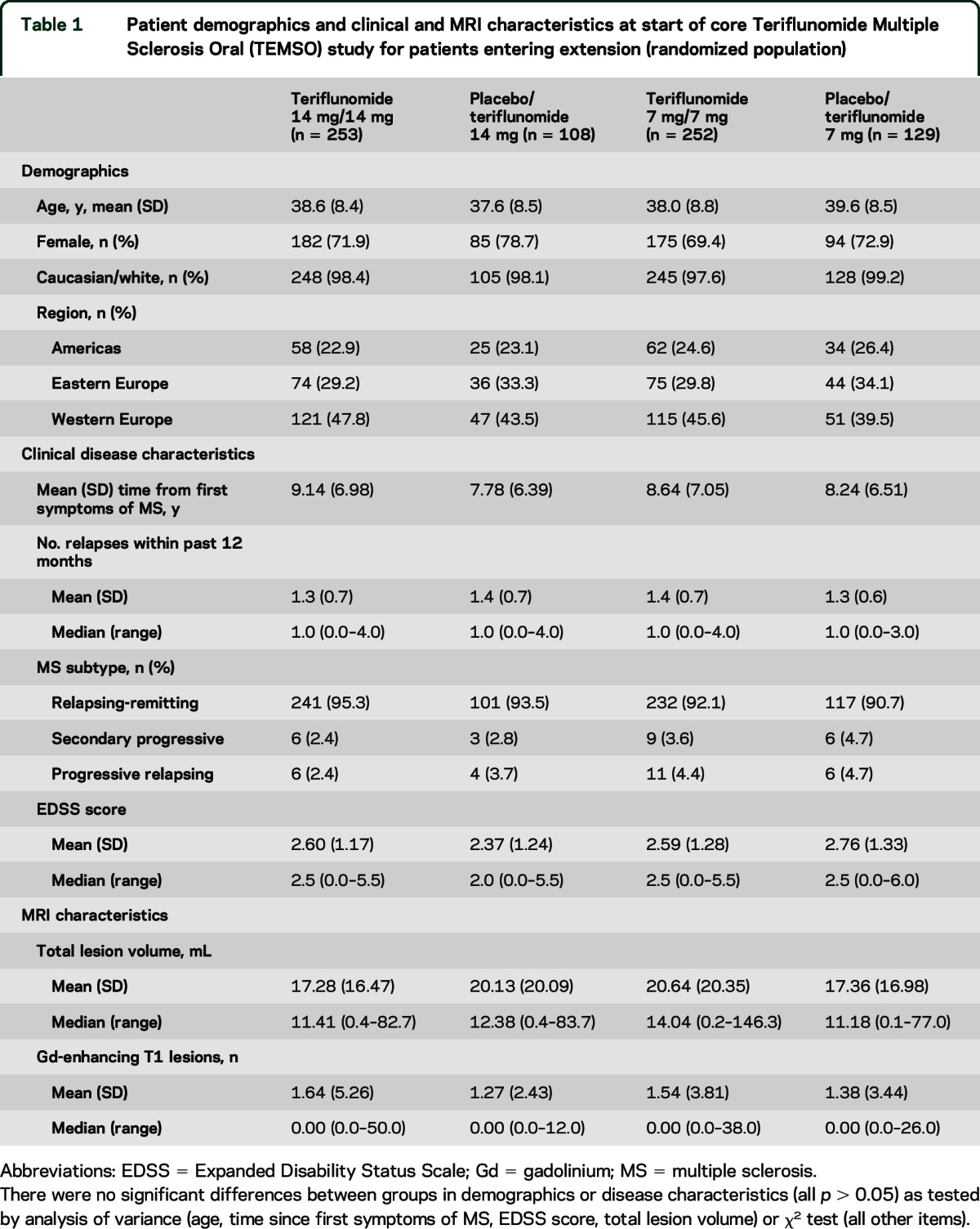
Patients who did not enter the extension.
Baseline data for those patients who did not enter the extension are shown in table e-1. This group had a higher mean EDSS score and more gadolinium (Gd)–enhancing T1 lesions at core study baseline and a greater proportion of patients with progressive disease compared with patients who entered the extension. These patients also had higher ARR and increased risk of disability progression at the end of the core study (table e-2).
Safety and tolerability.
Overview.
Over the extension, approximately 90% of patients reported at least 1 AE (table 2). The majority (∼80%) of patients who entered the extension experienced an AE in extension year 1. Consistent with findings in the core study, the most commonly reported AEs in the extension were nasopharyngitis, headache, and alanine aminotransferase (ALT) increase. Serious AEs were evenly distributed across groups, with no evidence of a dose effect (tables 2 and e-3A). AEs leading to discontinuation were reported in 82 patients (11% of the study population) without a dose effect (tables 2 and e-3B). The most common reason for discontinuation was confirmed ALT increase, which was required by protocol for ALT elevations >3× upper limit of normal (ULN) confirmed by a repeated measurement. Other AEs leading to discontinuation were relatively infrequent. Generally, for each individual AE, the number of episodes per patient was low (≤2.0) and similar across teriflunomide groups (table e-3C).
Table 2.
Adverse events (AEs) occurring in the extension (safety population)
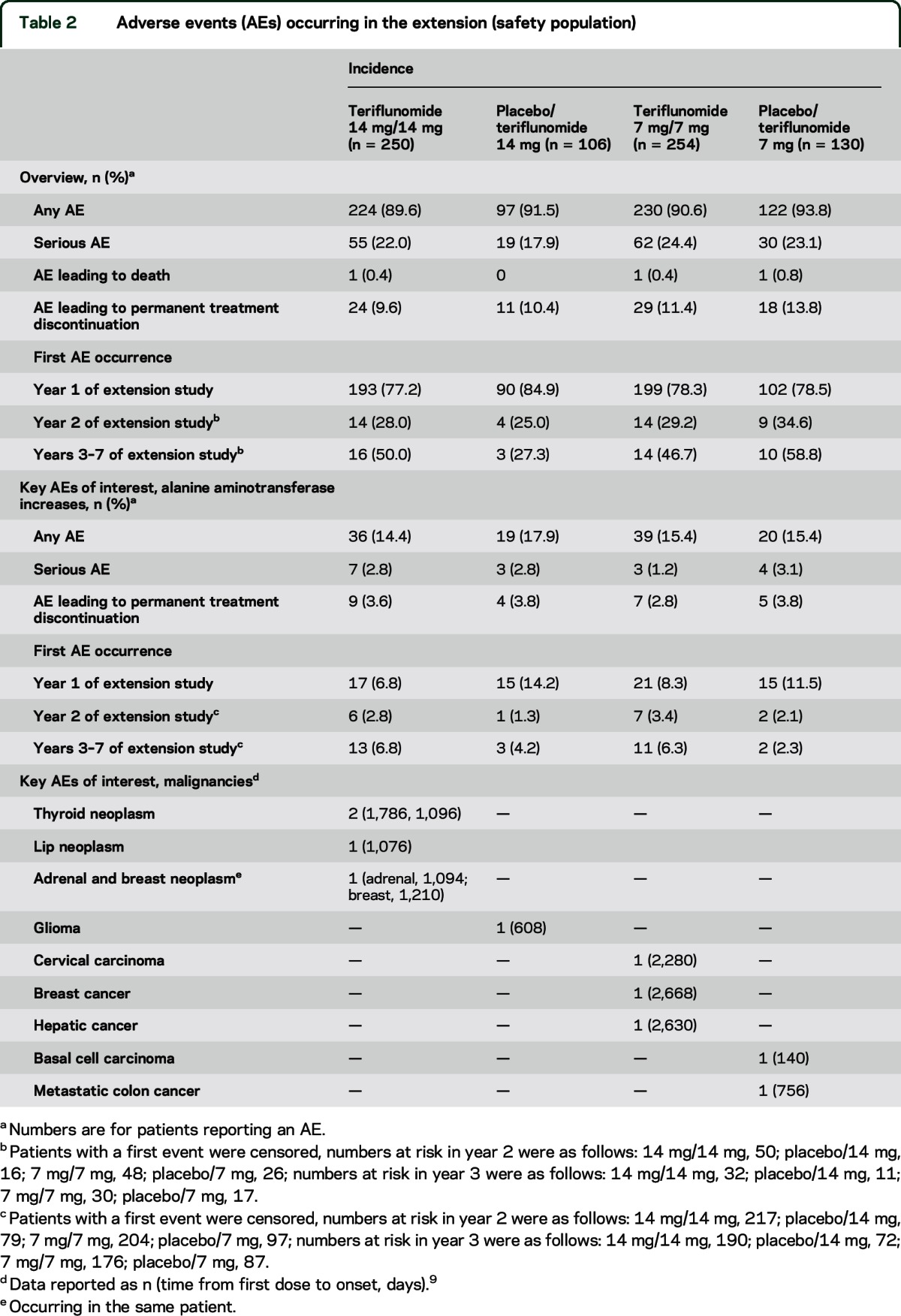
Hepatic disorders.
The most commonly reported hepatic disorder–related AEs were transient ALT elevations, reported as an AE as required by protocol. These occurred at a broadly similar incidence in the 4 treatment groups, and, as noted above, some cases led to treatment discontinuation (table 2). In extension year 1, first ALT elevations were more common in patients switching from placebo to teriflunomide than in patients continuing on teriflunomide; however, in subsequent years, first ALT elevations were low in all treatment groups. Patients with confirmed ALT elevations >3× ULN were monitored until their ALT levels normalized, and patients with ALT elevations of 2–3× ULN were monitored weekly until ALT was <1.5× ULN. ALT elevations were reversible in the majority of patients; for patients with ALT >3× ULN, median time to ALT normalization (to baseline or ≤ ULN) was 40 days, and 9 patients (11.4%) had values that did not return to normal. Two patients had ALT levels ≥3× ULN and total bilirubin ≥2× ULN, but these were explained by hepatitis A infection (patient discontinued owing to the hepatic enzyme elevation) and gallbladder disease (patient subsequently discontinued owing to gallbladder disease), respectively, and therefore did not meet the criteria for Hy law.
Malignancies.
There was no specific pattern of occurrence with respect to the cases of malignancies reported in the extension (table 2). No hematologic cancers (i.e., leukemia or lymphoproliferative tumors) were reported. The overall incidence of malignancies was 0.01 (mean follow-up 5.2 years), comparable to the general MS population in Sweden (0.11, mean follow-up 35.1 years).9
Peripheral neuropathy.
Peripheral neuropathy confirmed via electrophysical nerve conduction tests was reported for 9 patients receiving teriflunomide 14 mg (1 of whom had 2 events) and 5 patients receiving 7 mg. At the data cut, 8 events were ongoing, 3 were resolved with sequelae (mean duration 267 days), and 4 were resolved without sequelae (mean duration 429 days). Three patients discontinued owing to peripheral neuropathy (of these, 2 were classed as polyneuropathy); all 3 cases were considered potentially related to treatment.
Infections.
Infections were mainly mild in severity and of upper respiratory tract origin, including nasopharyngitis, influenza, sinusitis, and upper respiratory tract infections; there were few serious infections. Opportunistic infections (OIs)10 were uncommon. The most frequent OI was oral herpes, which occurred in 2.0%, 4.7%, 7.1%, and 2.3% of patients in the 14-mg/14-mg, placebo/14-mg, 7-mg/7-mg, and placebo/7-mg groups, respectively. There was a single OI event classified as serious in a patient in the 7-mg/7-mg group with oral herpes on day 1,011; the patient recovered in 9 days and did not discontinue treatment. There were no cases of tuberculosis and no discontinuations owing to OIs.
Hematologic disorders.
Neutropenia was reported in 2.8%, 5.7%, 2.4%, and 1.5% of patients in the 14-mg/14-mg, placebo/14-mg, 7-mg/7-mg, and placebo/7-mg groups, respectively. Leukopenia was reported in 2.0%, 3.8%, 3.5%, and 1.5% of patients, respectively. Six patients discontinued teriflunomide following hematologic disorders (appendix e-1), including patients with neutrophil counts <109/L, who were required to discontinue study treatment by protocol. Leukocyte and neutrophil counts over time in the whole study population, and neutrophil counts in patients who discontinued, are shown in figures e-2A and e-2B, respectively.
Hair thinning.
Hair thinning (coded as alopecia) was reported by 17% and 8% of patients in the placebo/14-mg and placebo/7-mg groups, respectively, and by ≤5% of patients in the other treatment groups (table e-3C). One case of hair thinning was considered serious by the treating physician (14-mg/14-mg group). No cases led to treatment discontinuation. The majority of patients recovered without requiring corrective treatment. In extension year 1, there was a higher incidence of first AE of hair thinning in patients switching from placebo to teriflunomide (placebo/14 mg, 15.1%; placebo/7 mg, 6.9%) than in patients continuing with teriflunomide (14 mg/14 mg, 1.2%; 7 mg/7 mg, 2.0%). In subsequent years, no such pattern was evident.
Hypertension.
Hypertension was reported in 10.8%, 6.6%, 6.3%, and 6.9% of patients in the 14-mg/14-mg, placebo/14-mg, 7-mg/7-mg, and placebo/7-mg groups, respectively (table e-3C). These events occurred in similar proportions of patients with (7.7%) and without (8.0%) a history of hypertension or antihypertensive treatment. In extension year 1, a first AE of hypertension was more common in patients switching from placebo (placebo/14 mg, 5.7%; placebo/7 mg, 5.4%) compared with those continuing on active treatment (14 mg/14 mg, 4.4%; 7 mg/7 mg, 3.9%). No events were considered serious, and there were no discontinuations owing to hypertension.
Pregnancies.
Despite the requirement for use of reliable contraception, a total of 14 pregnancies occurred during the extension study. Seven occurred in female patients (6 discontinued treatment, table e-3B), resulting in 4 live births, 1 induced abortion, and 2 spontaneous abortions; 7 occurred in partners of male patients, resulting in 5 live births, 1 induced abortion, and 1 spontaneous abortion. There were no signs of structural or functional deficits in the newborns.
Deaths.
Three deaths were reported, but none was considered by investigators to be related to study treatment. These occurred as follows: death in sleep from cause unknown (no autopsy performed) of a 44-year-old man who had received 3.8 years of treatment with teriflunomide 7 mg; death from unknown cause but with brain pathology consistent with an acute attack of MS in a 42-year-old woman with advanced MS who had received teriflunomide 7 mg for 3 years; and death from acute heart failure in the context of chronic coronary artery disease in a 37-year-old man who had received teriflunomide 14 mg for 3.5 years.
Efficacy outcomes.
Clinical outcomes.
There was a noticeable drop in ARR for the group of patients who received placebo in the core study as they switched to teriflunomide in the extension (figure 2A). ARRs declined over the extension and were numerically lower at the cutoff date than at the end of the core study in all treatment groups. The ARR for the combined core plus extension study periods was lower in patients who received teriflunomide throughout compared with those who began teriflunomide 7 mg after 108 weeks of placebo treatment (14-mg/14-mg group, p = 0.003; 7-mg/7-mg group, p = 0.022). There was a similar (albeit nonsignificant) effect for patients who received teriflunomide throughout compared with the placebo/14-mg group. Regardless of their dose allocation, ≥55% of patients did not experience a relapse in the extension (table 3).
Figure 2. Efficacy outcomes in the core Teriflunomide Multiple Sclerosis Oral (TEMSO) and extension studies (modified intent-to-treat population).
(A) Annualized relapse rate. (B) Mean EDSS score. (C) Number of Gd-enhancing T1 lesions. a Patients receiving placebo in the core study are shown as one group for this analysis. Week refers to time since start of core study. Week 108 is end of core study/start of extension study. Total number of Gd-enhancing T1 lesions defined as all lesions enhanced on T1 scan. *p < 0.005 compared with pooled placebo group; **p < 0.05 compared with placebo/7-mg group. CI = confidence interval; EDSS = Expanded Disability Status Scale; Gd = gadolinium.
Table 3.
Clinical and MRI outcomes in the core Teriflunomide Multiple Sclerosis Oral (TEMSO) and extension studies (modified intent-to-treat population)
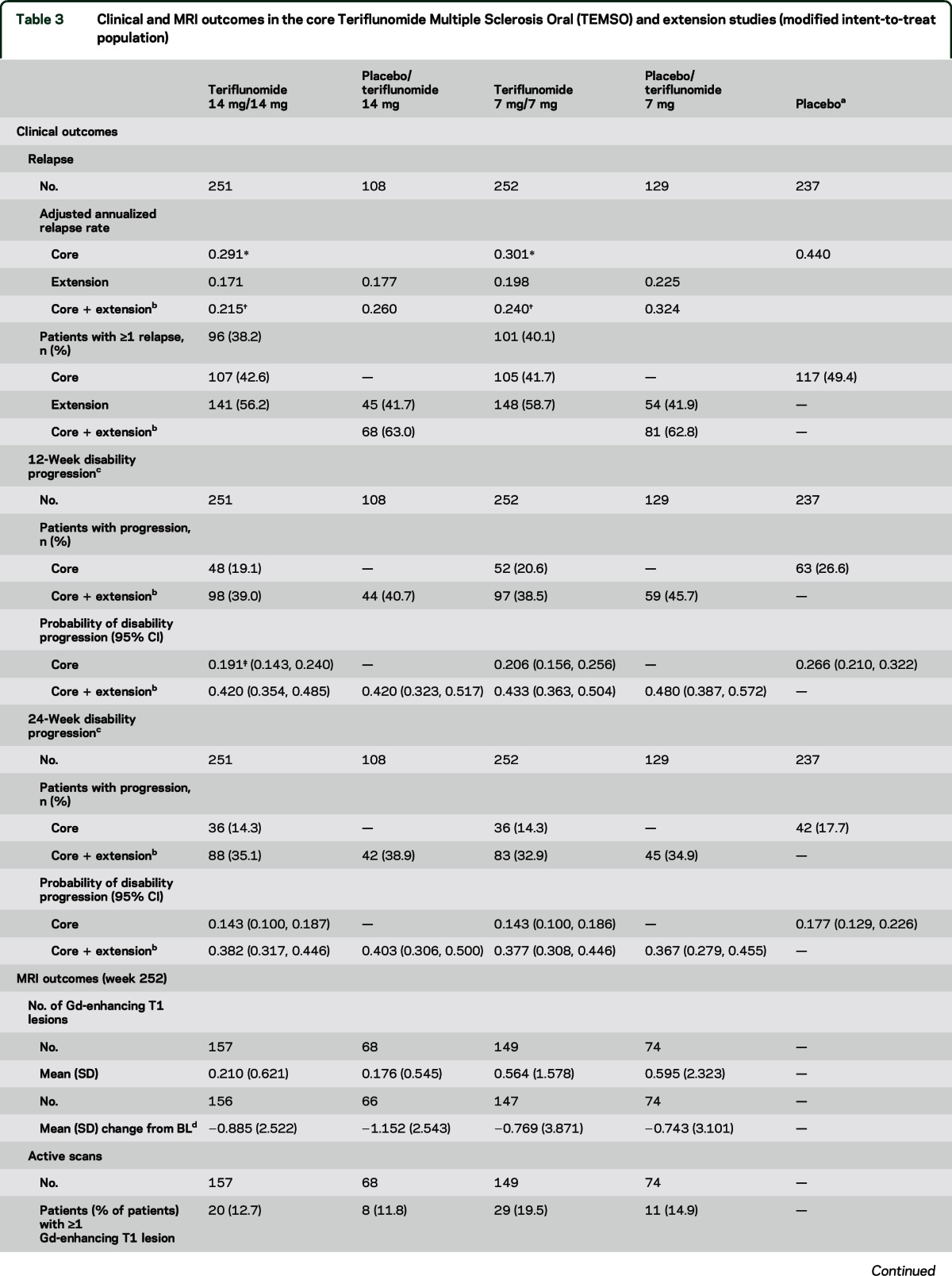
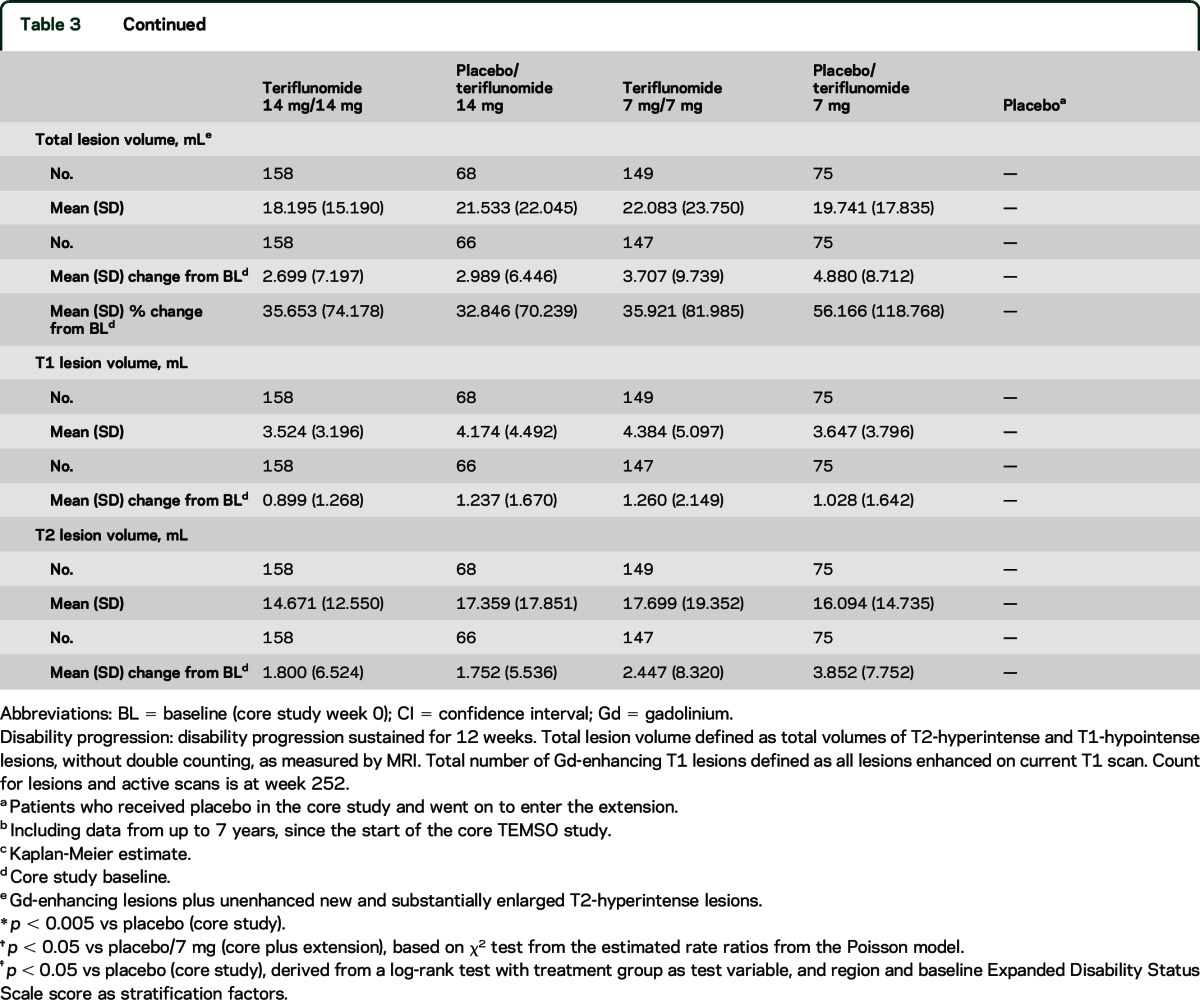
Overall, patients exhibited minimal disability progression: mean EDSS scores remained stable over time in the extension (figure 2B) with mean increases from core study baseline to week 348 of 0.46, 0.45, 0.22, and 0.24 points in the 14-mg/14-mg, placebo/14-mg, 7-mg/7-mg, and placebo/7-mg groups, respectively. It is worth noting that teriflunomide 14 mg reduced the risk of disability progression in the core study (p = 0.03 vs placebo), and after a sustained period with all patients receiving active treatment, there was a low rate of progression in all groups. Over the combined core and extension periods, the probability of disability progression sustained for either 12 or 24 weeks was <0.5 in all groups, and over half of patients did not experience any progression (table 3).
MRI outcomes.
We observed a decrease in the mean number of Gd-enhancing T1 lesions for the group of patients who received placebo in the core study as they switched to teriflunomide in the extension; mean Gd-enhancing T1 lesion count remained low thereafter (figure 2C). Most patients (≥80%) did not have Gd-enhancing T1 lesions during the study (table 3). Total lesion volume, and its component measures T1 and T2 lesion volume, remained relatively constant to week 252 (table 3).
DISCUSSION
This long-term extension of the pivotal phase 3 TEMSO trial indicated that both doses of teriflunomide were well-tolerated and had a consistent safety profile with up to 9 years of teriflunomide exposure. The nature and pattern of AEs reported with longer term exposure were consistent with those observed in the core phase of the TEMSO study3 and were in line with safety observations reported in other teriflunomide clinical trials.2,4,5,11 No new or unexpected AEs were reported with longer term exposure. Some of the AEs most commonly reported with teriflunomide, such as transient ALT elevations and hair thinning, appeared early in treatment; first incidence of these events then declined with continuing exposure.
The TEMSO extension study is markedly larger than the phase 2 extension, including approximately 5 times more patients. The safety observations from this study are consistent with those from the phase 2 extension, during which the nature and frequency of AEs did not change with up to 8.5 years of continued exposure.6 Malignancies were infrequent and there was no specific pattern of tumor types; no hematologic cancers were recorded. Combined with the low frequencies of serious infections, neutropenia, and leukopenia, this suggests that teriflunomide does not adversely affect immune function.
Similar to observations in the phase 2 extension,6 disability progression, ARR, and MRI activity remained low throughout the TEMSO extension, indicating that teriflunomide efficacy is maintained with long-term treatment. We observed marginally greater mean increases in EDSS in the 14-mg groups compared with the 7-mg groups; in contrast, in the phase 2 extension study, EDSS increases were smaller in the 14-mg group.6 As patients who received placebo in the core study switched to receive teriflunomide, there was a noticeable reduction in ARR and in the number of Gd-enhancing T1 lesions, which was sustained with continued treatment. A decline in Gd-enhancing T1 lesion numbers as placebo group patients entered the extension and low lesion numbers in patients continuing on active treatment were also observed in the phase 2 extension study.6 Although this study was not designed to compare immediate vs delayed treatment, post hoc analyses of ARR for the whole treatment period suggest that teriflunomide treatment should begin as early as possible to maximize benefits for the patient.
There are limitations associated with all long-term extensions that should be highlighted.12 First, there is no placebo control group during the extension, which limits interpretation. Second, long-term extensions may preferentially retain patients responding well to therapy (informative censoring), thus biasing the outcomes observed.12 However, although a number of patients did drop out over the course of the TEMSO extension, 63% of patients who entered the study remained in the extension at the interim analysis cutoff, and only 43 patients (6%) discontinued treatment for perceived lack of efficacy. This high retention rate could suggest high patient satisfaction with teriflunomide, an observation also made in other studies.5
Overall, the results of this study provide further evidence that the effects of teriflunomide are maintained with longer term treatment and also support previous observations that teriflunomide has a well-characterized and manageable long-term safety profile.
Supplementary Material
ACKNOWLEDGMENT
Review of this manuscript was provided by Larisa Miller and Steve Cavalier (Sanofi Genzyme, Cambridge, MA). Prof. Christian Confavreux (University Claude Bernard, Lyon, France), who died before this analysis of the TEMSO extension study was completed, was a member of the Steering Committee and contributed to the design and conduct of the TEMSO study and to the analysis and interpretation of the data.
GLOSSARY
- AE
adverse event
- ALT
alanine aminotransferase
- ARR
annualized relapse rate
- EDSS
Expanded Disability Status Scale
- Gd
gadolinium
- IFN
interferon
- MS
multiple sclerosis
- OI
opportunistic infection
- RMS
relapsing multiple sclerosis
- RRMS
relapsing-remitting multiple sclerosis
- TEMSO
Teriflunomide Multiple Sclerosis Oral
- ULN
upper limit of normal
Footnotes
Supplemental data at Neurology.org
Contributor Information
Collaborators: Teriflunomide Multiple Sclerosis Oral (TEMSO) Trial Group and the MRI-AC in Houston, Texas, E. Maida, E. Auff, F. Fazekas, T. Berger, V. Bhan, J-P Bouchard, P. Duquette, M. Freedman, F. Grand’maison, M. Kremenchutzky, C. Bourque, R.A. Marrie, M. Melanson, D. Patry, P. O’Connor, J. Oger, M. Stefanelli, F. Jacques, P. Venegas, M. Miranda, N. Barrientos, E. Tenhamm, S. Gloger, G. Rohde, J. Mares, J. Frederiksen, E. Stenager, S. Haldre, K. Gross-Paju, I. Elovaara, M-L Sumelahti, J-P Erälinna, J-P Erälinna, M. Färkkilä, H. Harno, M. Reunanen, T. Jolma, C. Confavreux, W. Camu, P. Clavelou, L. Magy, M. Debouverie, G. Edan, C. Lebrun-Frenay, T. Moreau, J. Pelletier, E. Roullet, S. Alamowitch, M. Clanet, P. Hautecoeur, P. Damier, L. Rumbach, A. Chan, S. Schimrigk, J. Haas, E. Lensch, H. Diener, V. Limmroth, D. Anders, M. Berghoff, P. Oschmann, M. Stangel, M. Berghoff, A. Frese, R. Kiefer, M. Marziniak, U. Zettl, E. Stark, K. Jendroska, G. Reifschneider, M.P. Amato, G. Comi, V. Cosi, P. Gallo, C. Gasperini, A. Ghezzi, M. Trojano, C. Pozzilli, E. Montanari, C.P. Zwanikken, P.J.H. Jongen, E.Th.L Van Munster, R.M.M. Hupperts, B. Anten, E.A.C.M. Sanders, E. Celius, H. Hovdal, S. Bohne Krogseth, W. Kozubski, H. Kwiecinski, A. Czlonkowska, Z. Stelmasiak, K. Selmaj, T. Hasiec, W. Fryze, W. Drozdowski, J. Kochanowicz, L. Cunha, J. De Sá, A. Harrington Sena, M. Odinak, A. Skoromets, E. Gusev, A. Boiko, N. Lashch, I. Stolyarov, A. Belova, N. Malkova, B. Doronin, E. Yakupov, L. Brundin, J. Hillert, L. Kappos, R. Karabudak, C. Irkec, E. Idiman, O. Turan, H. Efendi, M. Gedizlioglu, N. Buchakchyyska, A. Goloborodko, A. Ipatov, S. Kobets, V. Lebedynets, S. Moskovko, Y. Sanotskyy, V. Smolanka, V. Yavorskaya, D. Bates, N. Evangelou, C. Hawkins, B. McLean, J. O’Riordan, S. Price, B. Turner, D. Barnes, J. Zajicek, W. Honeycutt, O. Khan, L. Spikol, J. Stevens, P. A. Narayana, F. Nelson, S. Datta, I. Vainrub, B. Carrico, K. Ton, R. Brokhin, and L. Lambert
AUTHOR CONTRIBUTIONS
P. O'Connor, G. Comi, M.S. Freedman, A.E. Miller, L. Kappos, J.-P. Bouchard, C. Lebrun-Frenay, J. Mares, M. Benamor, K. Thangavelu, J. Liang, P. Truffinet, J.S. Wolinsky: design or conceptualization of the study and/or analysis or interpretation of the data. K. Thangavelu: analysis or interpretation of the data. P. O'Connor, G. Comi, M.S. Freedman, A.E. Miller, L. Kappos, J.-P. Bouchard, C. Lebrun-Frenay, J. Mares, M. Benamor, K. Thangavelu, J. Liang, P. Truffinet, V.J. Lawson, J.S. Wolinsky: drafting or revising the manuscript for intellectual content.
STUDY FUNDING
This study was funded by Sanofi Genzyme. Editorial support was funded by Sanofi Genzyme.
DISCLOSURE
P. O'Connor: consulting fee (Actelion, Bayer, Biogen Idec, BioMS, Cognosci, Daiichi Sankyo, EMD Serono, Genentech, Genmab, Novartis, Roche, sanofi-aventis, Teva, all related to MS clinical trials); contracted research (Actelion, Bayer, Biogen Idec, BioMS, Cognosci, Daiichi Sankyo, EMD Serono, Genentech, Genmab, Novartis, Roche, sanofi-aventis, Teva, for clinical trials work). G. Comi: consulting fee (Almirall, Bayer, Chugai, Excemed, Genzyme, Merck Serono, Novartis, Receptos, Sanofi, Serono Symposia International Foundation [SSIF], Teva); fees from non-CME services (Almirall, Bayer, Biogen, Excemed, Genzyme, Merck Serono, Novartis, Receptos, Sanofi, SSIF, Teva). M. Freedman: consulting fee (Bayer HealthCare, Biogen Idec, Chugai, EMD Canada, Genzyme, Novartis, sanofi-aventis, Teva Canada Innovation); advisory board or board of directors (Bayer HealthCare, Biogen Idec, Hoffman La-Roche, Merck Serono, Novartis, Opexa, sanofi-aventis); speakers bureau (Genzyme). A. Miller: consulting fee (Accordant Health Services, Biogen Idec, EMD Serono [Merck Serono], Genzyme/sanofi-aventis, GSK, Novartis, Nuron Biotech, Questcor, Teva); contracted research (Acorda Therapeutics, Biogen Idec, Genentech, Genzyme, Novartis, Questcor, Roche, sanofi-aventis). L. Kappos: author's institution (University Hospital Basel) has received in the last 3 years and used exclusively for research support: steering committee, advisory board, and consultancy fees (Actelion, Addex, Bayer HealthCare, Biogen Idec, Biotica, Genzyme, Lilly, Merck, Mitsubishi, Novartis, Ono Pharma, Pfizer, Receptos, sanofi-aventis, Santhera, Siemens, Teva, UCB, Xenoport); speaker fees (Bayer HealthCare, Biogen Idec, Merck, Novartis, sanofi-aventis, Teva); support of educational activities (Bayer HealthCare, Biogen, CSL Behring, Genzyme, Merck, Novartis, Sanofi, Teva); royalties (Neurostatus Systems GmbH); grants (Bayer HealthCare, Biogen Idec, Merck, Novartis, Roche, Swiss MS Society, the Swiss National Research Foundation, the European Union, Roche Research Foundations). J. Bouchard: consulting fee (Biogen Idec, EDM Serono, Novartis, Roche, sanofi-aventis, Teva Canada); grant/research support (Biogen Idec, EDM Serono, Novartis, sanofi-aventis). C. Lebrun-Frenay: consulting fees, honoraria, or scientific committees support (Allergan, Almirall, Bayer Schering, Biogen Idec, Genzyme, Merck Serono, Novartis, Sanofi, Teva). J. Mares: author's institution has received research and speaker fees support from Genzyme/sanofi-aventis. M. Benamor: employee of Sanofi Genzyme. K. Thangavelu: employee of Sanofi Genzyme. J. Liang: employee of Sanofi. P. Truffinet: employee of Sanofi Genzyme. Ownership interests: Sanofi stocks. V. Lawson: employee of Fishawack Communications Ltd., contracted to provide editorial services to Sanofi Genzyme. J. Wolinsky: royalties (royalty payments through the University of Texas Health Science Center at Houston for monoclonal antibodies out-licensed to Chemicon International); consulting fee (AbbVie, Actelion, Alkermes, Athersys, Inc., EMD Serono, Forward Pharma, Genentech, Genzyme, Novartis, Roche, Teva, Teva Neurosciences, to-BBB technologies, XenoPort); contracted research (Genzyme, Sanofi, the NIH, and the National Multiple Sclerosis Society through the University of Texas Health Science Center at Houston). Go to Neurology.org for full disclosures.
REFERENCES
- 1.Bar-Or A, Pachner A, Menguy-Vacheron F, Kaplan J, Wiendl H. Teriflunomide and its mechanism of action in multiple sclerosis. Drugs 2014;74:659–674. [DOI] [PMC free article] [PubMed] [Google Scholar]
- 2.O'Connor PW, Li D, Freedman MS, et al. A phase II study of the safety and efficacy of teriflunomide in multiple sclerosis with relapses. Neurology 2006;66:894–900. [DOI] [PubMed] [Google Scholar]
- 3.O'Connor P, Wolinsky JS, Confavreux C, et al. Randomized trial of oral teriflunomide for relapsing multiple sclerosis. N Engl J Med 2011;365:1293–1303. [DOI] [PubMed] [Google Scholar]
- 4.Confavreux C, O'Connor P, Comi G, et al. Oral teriflunomide for patients with relapsing multiple sclerosis (TOWER): a randomised, double-blind, placebo-controlled, phase 3 trial. Lancet Neurol 2014;13:247–256. [DOI] [PubMed] [Google Scholar]
- 5.Vermersch P, Czlonkowska A, Grimaldi LM, et al. Teriflunomide versus subcutaneous interferon beta-1a in patients with relapsing multiple sclerosis: a randomised, controlled phase 3 trial. Mult Scler 2014;20:705–716. [DOI] [PubMed] [Google Scholar]
- 6.Confavreux C, Li DK, Freedman MS, et al. Long-term follow-up of a phase 2 study of oral teriflunomide in relapsing multiple sclerosis: safety and efficacy results up to 8.5 years. Mult Scler 2012;18:1278–1289. [DOI] [PMC free article] [PubMed] [Google Scholar]
- 7.Li DB, Traboulsee AL, Tuffinet P, Dukovic D, O'Connor PW. Long-term MRI outcomes from patients treated with teriflunomide: results from a phase 2 extension study (P079). Mult Scler 2014;20:67–284.25205048 [Google Scholar]
- 8.Vucic S, Parratt J, Li DK, et al. Long-term clinical and MRI outcomes from teriflunomide extension studies (P34). Taipei, Taiwan: PACTRIMS; 2014. [Google Scholar]
- 9.Bahmanyar S, Montgomery SM, Hillert J, Ekbom A, Olsson T. Cancer risk among patients with multiple sclerosis and their parents. Neurology 2009;72:1170–1177. [DOI] [PubMed] [Google Scholar]
- 10.Kaplan JE, Benson C, Holmes KK, Brooks JT, Pau A, Masur H. Guidelines for prevention and treatment of opportunistic infections in HIV-infected adults and adolescents: recommendations from CDC, the National Institutes of Health, and the HIV Medicine Association of the Infectious Diseases Society of America. MMWR Recomm Rep 2009;58:1–207; quiz CE201–CE204. [PubMed] [Google Scholar]
- 11.Miller AE, Wolinsky JS, Kappos L, et al. Oral teriflunomide for patients with a first clinical episode suggestive of multiple sclerosis (TOPIC): a randomised, double-blind, placebo-controlled, phase 3 trial. Lancet Neurol 2014;13:977–986. [DOI] [PubMed] [Google Scholar]
- 12.Sormani MP, Bruzzi P. Can we measure long-term treatment effects in multiple sclerosis? Nat Rev Neurol 2014;11:176–182. [DOI] [PubMed] [Google Scholar]
Associated Data
This section collects any data citations, data availability statements, or supplementary materials included in this article.



